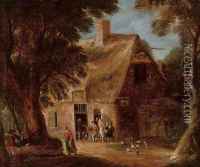Joos Cornelisz. Droochsloot Paintings
Joos Cornelisz. Droochsloot was a Dutch Golden Age painter born in Utrecht in 1586. He was primarily known for his genre paintings and landscapes that often included lively scenes of villages or towns with numerous figures. Droochsloot's work provides a valuable visual record of 17th-century life in the Netherlands, as he depicted everyday activities of the peasantry as well as the middle class.
Droochsloot began his artistic career after joining the Utrecht Guild of Saint Luke in 1616. He became a respected master in the guild, and his works gained recognition for their detailed portrayal of Dutch society. Although not as widely known as some of his contemporaries like Rembrandt or Vermeer, Droochsloot's paintings were appreciated for their narrative quality and his ability to capture the essence of Dutch culture during the period.
Throughout his career, Joos Cornelisz. Droochsloot painted various subjects, but he is especially remembered for his depictions of village kermises, landscapes with bandits, and moralistic scenes that often included proverbs or sayings. His style was influenced by the works of Pieter Brueghel the Elder, whose genre scenes were also characterized by bustling community life and attention to the details of daily existence.
Droochsloot's paintings are characterized by their crowded compositions and vivid representations of characters from different walks of life. His use of color and light brought these scenes to life, while his sense of humor and satire often came through in the facial expressions and activities of the figures he depicted. Despite the popularity of his genre scenes, little is known about his patrons or the specific commissions that might have sustained his career.
Joos Cornelisz. Droochsloot continued to work and live in Utrecht until his death in 1666. His works can be found in various museums, and they continue to be studied by art historians interested in the Dutch Golden Age and the social context of the period. Droochsloot's legacy is that of a skilled painter who captured the vibrancy and complexity of 17th-century Dutch society, making his works a valuable part of the cultural heritage of the Netherlands.
